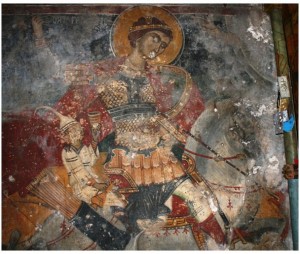Who is that boy with St. George?
18 km north of Paleochora, just outside Kandanos, lies the village of Plemeniana and tucked away on the left hand side of the road as one travels towards Kandanos is the church of Agios Giorgos –St George – the frescoes in which have been dated to around the start of the fifteenth century.
Of particular interest is the painting of St George himself; shown on horseback in the act of slaying the dragon. However, St George is not alone on his horse in this painting; behind him on the back of his horse sits a young man holding a cup and a jug.
Almost totally unknown in the St George legend west, this figure relates to a story told in three different versions, the earliest of which dated back to the eleventh century.
This tells the tale of an Arab raid into the Byzantine held lands of Paphlagonia, on the southern coast of the Black Sea, and the capture of a young boy by the raiders. The boy, a servant in the church of St George in Phatris, refused to give up Christianity but, on account of his great beauty, rather than having him killed, the Arab leader put him to work in his kitchen. The boy prayed to St George for salvation and one night the saint miraculously appeared, put the boy on the back of his horse and rode off with him. Later that night the saint dropped the boy off in a building where he fell asleep. He was woken the next morning by people who were scared of him because, still being dressed in his Arab clothing, they thought he was part of another force of raiders. The boy recognised the people surrounding him as Orthodox monks; he’d been brought back to the Monastery of St. George in Phatris.
In the second version of the tale, again from Paphlagonia, the boy, still called George, is the son of an old soldier and he goes in the army of the Byzantine Emperor Phocas to fight the Bulgarians invading the northern part of the empire. The emperor was defeated and George was taken captive by the Bulgarian king who put him to work serving at the king’s table. On the eve of the feast of St. George, the boy’s mother prayed to the saint for her son’s wellbeing. That same evening the Bulgarian king ordered the boy to fetch a jug of hot water. When he went to get it, the saint appeared in front of him and ordered him to mount up behind him on his horse, miraculously transporting the boy back to the very church where his mother was praying for him. As in the earlier version of the tale he wasn’t at first recognised because of his Bulgarian clothes but soon convinced his mother that he had in fact returned.
The third and latest version of the myth locates the boy George, the son of a pious widow, in the town of Mytilene, on the island of Lesbos. In this version the boy is captured by Arab raiders from Crete and becomes the servant of the Emir of Crete. As before, his mother prayed to St, George on his feast day and George was taken up by the saint while serving wine to the Emir and was returned to Mytilene, wine glass in hand.
According to one expert:
“ The motif of kidnapping a handsome adolescent and then making him a steward was common among the Greeks because of the classical myth about Ganymede, son of the Trojan king Tros (or Laomedon), who was captured by Zeus or Cretan Minos. Both stories are connected not only by the character of the young cupbearer, but also by the place where he was captured. According to different versions it happened on Mount Ida in Troas, in the town of Harpage in Mysia in Asia Minor, or on Crete.”
Though based on earlier pre-Christian legends, the events which are described in two of the Christian versions of the tale can probably be traced to certain actual occurrences. The second version of the tale appears to refer to the defeat, while campaigning against the Bulgarians under Tsar Symeon, of the army of “domestikos ton scholon” Leo Phocas – a senior army commander in the Byzantine army – at the battle at the Achelos river near Anchialos on the Bulgarian Black Sea coast on 20 August, 917: the third version appears to be referring to the period of the Arab control of Crete, 824 to 961, and the Arab attack on Lesbos in around 867.
So then, the boy in question combines both pre Christian and Christian legends along with memories of actual events 50 years and hundreds of kilometres apart.
Nothing whatsoever to do with Gary Glitter & Jimmy Savile, then. Phew!



Recent Comments